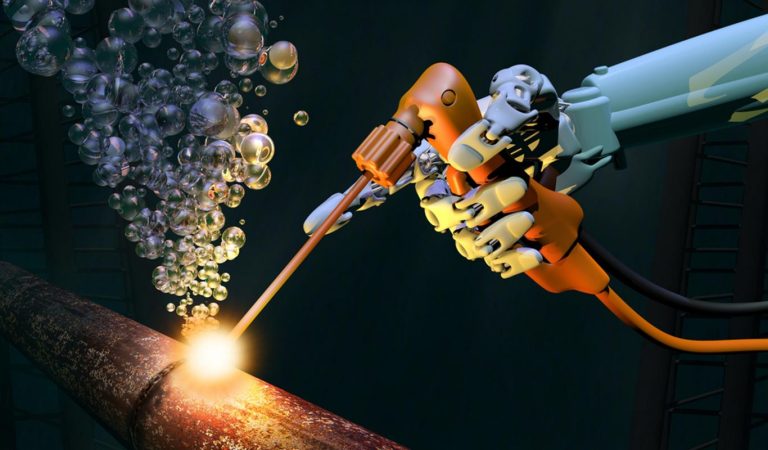Welding can be lucrative work, but it is also handy for personal use at home or in the workshop. With a good welding machine, a protective helmet, and a sturdy welding jacket, you can easily begin to craft and repair objects on your own. But, before we let you get into that, let’s explore the basics.
What Is Welding?
Welding is the process of joining materials by melting them and letting them come together into a fusion and creating a singular finished product.
Some welding methods require pressure, or a combination of heat and pressure to join materials, distinguishing them from other forms of combining materials such as soldering or brazing.
In soldering and brazing, base materials remain unchanged. A third filler material is melted between the surface of the workpiece and the joined piece, creating a bond that’s as strong as that filler material.
Welding, on the other hand, always changes the structure of the finished product. Since both the original piece and the joined piece are superheated, the pieces get melted together and reformed to create a robust and cohesive bond.
The fundamental goal of welding is to fuse two pieces so that the strength of the combined piece is more substantial than the original pieces. How the welding process works vary depending on the welding type.
Arc Welding
Arc welding relies on an electrical arc to melt the work and filler materials in the joints. A grounding wire is attached to the weld material, creating the arc, while another wire, called the electrode lead, is placed onto the material to be welded.
In the past, welders would use an oxy-fuel torch to generate the heat needed to melt the workpieces; however, arc welding has since taken its place as the most common type of welding. As the charge passes from the electrode to the workpieces, it creates an arc of electricity.
Pulling the lead from the material generates this electric arc, which is strong enough to melt the work and filler material to join them.
The MIG welder and TIG welder are the two most common machines used in arc welding. Both methods rely on the aforementioned electrical arc, but the main difference is the method of using filler material.
In MIG welding, a metal filler material is machine-fed through the gun, ignited, and liquified to join the pieces together. The gun also dispenses argon, an inert gas, to prevent impurities in the air from entering the molten pool and causing imperfections.
On the other hand, TIG welding requires the user to hold the filler material and place it in the electric arc to create an effective join. In both, an inert gas shields the electrical arc from impurities in the air, which can cause the material to become porous.
Another type of arc welding worth mentioning is shielded metal arc welding (SMAW), commonly referred to as stick welding. Stick welding relies on a consumable electrode covered in flux to generate the arc. This process then melts the filler and joins the workpieces.
Gas Welding
Gas welding, unlike arc welding, relies on fuel gas to generate heat. The heat melts the surface of the welding plates, which forms joints.
The most common type of gas used is oxyacetylene gas. With gas welding, a filler material is optional but may prove beneficial in some situations. Steel cylinders house the gas while pressure regulators and flashback arrestor safety devices monitor the amount of gas fed through the torch.
Laser Welding
Lasers (Light Amplification by Stimulated Emission of Radiation) have only been around for 60 years and have only recently seen use in welding disciplines. For companies that can afford them, laser welding machines are modern marvels that provide immaculate work and allow programming to the most precise specifications.
The goal of the weld, once more, is to melt the original piece and the workpiece. But, instead of using an electric arc or gas, lasers are the source of energy to weld materials together.
While lasers might not be as powerful as arc or gas welding, the prospect of using Computer-Aided Design (CAD) and Computer-Aided Manufacturing (CAM) systems in the process allows for precise work.
Why Is Welding Important?
People use welding in various situations, employing different methods to accomplish their goals.
MIG welding, for example, is often used in industrial settings to quickly and efficiently set welds while TIG welding is preferable when aesthetics are more critical and generally creates a stronger weld.
The construction industry relies heavily on welders to create solid and hardy joins that reinforce the material and prevent it from breaking down prematurely.
Fusing materials by welding makes them stronger than ever and are aspects of nearly every significant part of construction, from boats and bridges to homes and automobiles. In these examples, different welding methods are necessary to create strong joints.
Aside from the numerous welding methods with different underlying principles, there are also other types of welding joints that a welder needs to understand to reinforce a structure properly, including the following:
- Butt joints
- Cruciform joints
- Lap joints
- T-joints
- Corner joints
In almost any manufacturing project, welding is necessary to fuse materials and make them stronger, which is why any aspiring welder needs to understand how the welding process works.
The Bottom Line
Welding is the process of joining two or more materials together by melting them and letting them cool into one finished piece that is stronger than the original.
Different methods rely on other filler materials, gasses, and methods of melting the workpieces, each having merit in the construction industry.
Welding provides lucrative skills for employment, as there are always items that need repair or others needing construction using an expert touch. However, it is also used at home or in a personal workshop, allowing the repair, strengthening, and construction of a multitude of objects.

